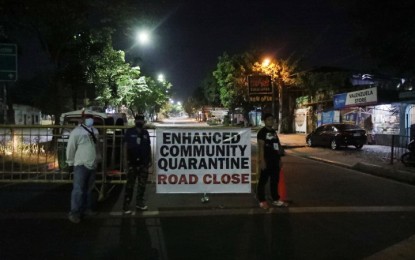
MANILA – Metro Manila, Laguna and Cebu City will be placed under a “modified” enhanced community quarantine (ECQ) from May 16 to 31.
This developed after President Rodrigo Duterte on Monday night approved the Inter-Agency Task Force for the Management of Emerging Infectious Diseases (IATF-EID) Resolution No. 35 which recommends areas deemed still at high risk of coronavirus disease (Covid-19) infection to be placed under a less stringent ECQ.
In a virtual presser on Tuesday, Presidential Spokesperson Harry Roque explained that a modified ECQ (MECQ) is a community quarantine which will allow the operation of selected manufacturing and processing plants up to a maximum of 50 percent workforce.
Limited transporting services for essential goods and services will also be allowed under MECQ, he added. However, face-to-face classes in all schools will remain suspended.
"It is not ECQ as we know it. It is not GCQ (general community quarantine) as we know it. It's somewhere in between. It is a transition phase po at ini-envision natin na matapos ang one month, makakapunta na tayong lahat sa GCQ (we envision that after one month, we will all transition to GCQ)," Roque said.
The IATF resolution also declared a GCQ in eight areas with moderate risk of infection namely Cagayan Valley (Region 2); Central Luzon (Region 3); Calabarzon (Region 4-A); Cordillera Administrative Region (CAR); Central Visayas (Region 7) except Cebu City; Zamboanga Peninsula (Region 9); Davao Region (Region 11); and Caraga (Region 13).
Eight areas with low risk of infection will no longer be under ECQ or GCQ. These are Ilocos (Region 1); Mimaropa (Region 4-B); Bicol (Region 5); Western Visayas (Region 6); Eastern Visayas (Region 8); Northern Mindanao (Region 10); Soccsksargen (Region 12); and Bangsamoro Autonomous Region in Muslim Mindanao (Barmm), the IATF resolution noted.
Minimum health standards must be observed in areas not under ECQ or GCQ.
“Hanggang walang vaccine kinakailangan minimum health standards. Iyong mga minimum health standards – social distancing, good hygiene, temperature control, temperature checks at iba pang mga pini-prescribe po ngayon ng DOH (For as long as there is no vaccine, minimum health standards are needed. These are social distancing, good hygiene, temperature control, temperature checks and others prescribed by the Department of Health),” Roque said.
The IATF took into consideration the proposal of Metro Manila mayors to extend the ECQ for another 15 days, Roque said.
Provinces, highly urbanized cities (HUCs), and independent component cities (ICCs) characterized as low, moderate, and high-risk may appeal their classification to the IATF Screening and Validation Committee not later than May 13, he added.
The ECQ in Metro Manila; Central Luzon, except Aurora; Calabarzon; Benguet; Pangasinan; Iloilo province; Cebu province; Bacolod City; Davao City, Zamboanga City, and Albay province will end on May 15.
The GCQ, with relaxed quarantine measures, is currently being implemented in all low-risk and moderate-risk areas nationwide since May 1.
There are 11,086 confirmed cases of Covid-19 in the country, with 726 deaths and 1,999 recoveries as of Monday (May 11).
Meantime, Roque said the IATF has also proposed a general concept of identifying zones with Covid-19 cases.
The “critical zone” refers to an area with more than 20 cases; a “containment zone” means that there are between 1-19 cases in the area; a “buffer zone” refers to an area with no cases but contiguous with localities with cases; and “outside of buffer zone” refers to areas outside of the buffer zones without confirmed cases.
On Monday night, Duterte held a meeting with Cabinet and IATF members to discuss the fate of the ECQ and GCQ.
In a taped public address aired on Tuesday, Duterte deferred the announcement of his decision and instead used his speech to warn the public against the Covid-19 threat. (PNA)
